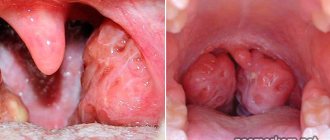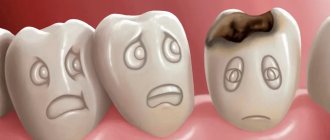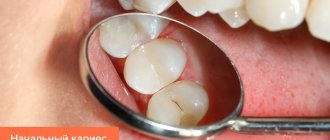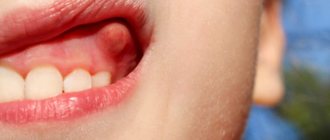Teeth are of great importance for human health, therefore proper care and caring attitude towards them must be instilled from childhood. Some parents are in no hurry to treat their children’s baby teeth, believing that they will soon fall out anyway, but this is a fundamentally wrong judgment. What is the danger of such a misconception?
Caries is a destructive process characterized by softening of the hard tissues of the tooth, due to which carious cavities form. These empty cavities are a repository of bacteria that do not stop their impact on the child’s milk teeth, later moving on to permanent ones. But the infectious carious process is localized not only on hard enamel, it quickly spreads to soft tissues and begins to form pus. When the infection gets into the soft tissues, caries is especially dangerous due to its complications - it can provoke meningitis, thrombophlebitis, sepsis, abscess, phlegmon, and vein thrombosis. With weak immunity, the child’s ENT organs – ears, nose and throat – are involved in the disease.
Also, without treatment, caries of primary teeth affects:
- well-being and mood. Every adult is familiar with the pain of toothache, even if it is periodic, and the baby experiences it no easier.
- appearance. Untimely removal of baby teeth can cause problems with the child’s bite and appearance (face shape).
- communication and social life. Ugly teeth can be a subject of ridicule from peers and cause an inferiority complex in society. They are also directly involved in the process of developing spoken language, and for this their normal development is important. Dental health plays a big role in the socialization of a child.
- further attitudes towards doctors and fears about visiting hospitals. If caries starts before the need to remove a baby tooth, a visit to the dentist will be clearly traumatic for the child’s psyche and may lead to a fear of dentists, which will not be easy to eradicate.
- nutrition. With caries, negative reactions to sweets, hot and cold are possible - such restrictions greatly impoverish the child’s diet and, in addition to pain, spoil his mood.
general information
Tooth enamel has high hardness and strength. This property allows you to reliably protect the underlying layers from mechanical damage and inflammation. However, in some cases, intense mechanical stress can lead to cracking of the enamel. Shallow and short defects often go unnoticed, but without treatment over time they become deeper and darker in color. Without treatment, cracks can become entry points for infection - through damaged enamel, pathogenic bacteria penetrate into dentin and pulp, causing extensive inflammation.
Both children and adults face the problem of enamel cracks. Regardless of the patient’s age, it is important not to delay a visit to the dentist so that the destruction does not progress.
Prevention of caries of anterior teeth
Follow simple recommendations.
- Brush each tooth thoroughly twice a day. The front dentition is cleaned with vertical movements of the brush. The back surface of the front teeth is sweeping.
- Get a medical examination and professional hygiene at least once every 6 months.
- Eat right: include raw vegetables and fruits in your diet, limit sweets and starchy foods.
- Carry out remineralization - minerals strengthen tooth enamel.
Caries of the front teeth is unsightly, unpleasant and painful. Stop hiding your smile and experiencing constant discomfort! Teeth need to be treated in a timely manner; delaying only aggravates the problems. Our clinic specialists know what needs to be done to keep your smile healthy. They will carry out jewelry work: remove tissues affected by caries, return the teeth to their original shape and beauty. Make an appointment right now!
Causes of enamel cracks in children
The main condition for the appearance of an enamel crack is an impact that exceeds its safety factor. This can happen either when it becomes thinner or due to very severe trauma (both instantaneous and regular). The list of the most common causes of pathology includes:
- blows falling on the tooth area;
- the habit of chewing candy, nuts and other hard foods, as well as opening bottles with teeth, etc.;
- use of pastes with a large number of abrasive components;
- deficiency of vitamins and minerals, leading to thinning of the enamel;
- bruxism: grinding teeth while sleeping;
- dental errors when treating caries and performing other manipulations;
- abuse of products that corrode enamel (certain types of soda, fruit, etc.);
- wearing braces;
- poor oral care;
- orthodontic problems leading to uneven load on the dentition during chewing.
Holes in baby teeth at 3 years of age: treatment of the superficial and middle stages
These types of lesions can be eliminated by cleaning the cavity with an instrument or using a drill. An anesthetic is administered before the procedure. In most cases, children are afraid of such procedures, which complicates the treatment process. Composites of different colors are used as filling materials. The child can independently choose the shade he likes; this often helps relieve fear and arouse interest in the procedure.
Modern clinics also use other methods for treating caries in three-year-old children:
- Chemical-mechanical. The area affected by caries is treated with a special solution, then the softened dead tissue is removed with an instrument.
- Air abrasive. The cavity is treated using a stream of water, air and abrasives.
- Ultrasonic. Ultrasonic waves affect the cavity. As a result of such manipulations, the affected tissue easily comes off.
- Laser. The laser beam ideally disinfects the affected area.
Such techniques allow pediatric dentists to quickly and painlessly eliminate caries at various stages of development.
Types (classification) of tooth cracks in children
Most often, tooth cracks in children are divided into types depending on the direction and location. The following types of pathology are distinguished:
- vertical: pass from the coronal part to the root; if the defect covers a significant part of the tooth, restoration is practically impossible;
- horizontal: pass in the transverse direction, often causing enamel chips;
- oblique: they walk obliquely, often remaining unnoticed;
- internal: capture the internal layers, are detected after a fracture or on an x-ray;
- root: located in the root area;
- at the base: located in the cervical part.
Depending on the depth, superficial and deep cracks are distinguished, and depending on the number, single and multiple.
What is bottle caries of baby teeth?
Bottle caries can occur almost immediately after teething if the baby is bottle-fed and cariogenic bacteria enter the newborn’s oral cavity. They begin to eat milk, which has a lot of sugar. The mouth creates a favorable environment for the proliferation of microbes. Since the incisors appear first, caries of the front teeth occurs. It develops in exactly the same way as other varieties of this pathology. Complications may arise if parents do not bring the baby to the dentist for examination.
Symptoms of cracked teeth
Even if the crack is located on the child’s front tooth, it is not always noticeable. The defect is visible when it is of significant depth and extent, as well as when it gradually stains. Only a dentist can notice the problem in the early stages.
In some cases, additional symptoms appear, the presence and severity of which depend on the depth and location of the defect:
- pain or discomfort at rest and/or when chewing food;
- increased sensitivity to hot, cold, sour, etc.;
- bad breath;
- local change in enamel color;
- inflammation of the gums in the area of the defect, their bleeding.
Stages of caries
- At the initial stage, white spots appear on the enamel. They can be completely different in shape and size. The process of destruction of enamel can be prevented if the child is shown to the doctor in a timely manner.
- Surface. The disease develops within the enamel layer. The cavity may be light or darkened. The child reacts painfully to sweet, sour, and hot foods. The main method of treatment at this stage is filling.
- Average. The dentin tissue is affected, and the pain becomes stronger. In this case, the cavity needs to be cleaned and filled.
- Deep. Most of the dentin is affected by caries. The baby may experience severe pain.
If you do not show your child to the dentist in a timely manner, possible complications may include serious diseases such as pulpitis and periodontitis. In addition, a diseased permanent tooth may grow in place of an untreated fallen tooth.
What are the dangers of cracked teeth in children?
Even a superficial defect in tooth enamel can negatively affect the condition of the tooth. If you let the situation take its course, over time the cracks can lead to unpleasant consequences:
- development of caries, gingivitis, periodontitis due to the accumulation of plaque in the defect;
- chips of the enamel, which, in turn, injure the tongue and mucous membranes;
- penetration of infection into the pulp with the development of pulpitis and other emergency conditions;
- premature loss of a tooth unit.
Reasons for the development of caries on baby teeth at 3 years of age
At 3 years of age, baby teeth are more susceptible to caries than molars. Carious lesions are a serious pathology that makes itself felt after the eruption of teeth. Demineralization occurs, hard tissues gradually soften, resulting in the formation of holes.
Below we consider the main reasons for the development of disease on baby teeth:
- If in the first trimester of pregnancy a woman suffered from serious illnesses and took certain types of medications, there is a high probability that the development of the baby’s tooth buds will be disrupted. The result of this in the future may be progressive caries.
- Caries is infectious in nature. Therefore, it can be transmitted to the baby from parents while eating from the same dishes.
- Poor oral hygiene is the main reason for the development of pathology. Children should be taught to brush their teeth correctly as early as possible. When the baby's first tooth erupts, hygiene can begin. You can find special silicone brushes on sale that will gently and carefully clean your teeth of plaque.
- Excessive consumption of sweets can also lead to the formation of holes in the teeth.
- Bad habits in childhood. For example, drinking sweet drinks from a bottle at night can provoke so-called “bottle” caries, which by the age of three will take on a deep form. The disease first affects the incisors. After dinner and brushing teeth, children should not be given sweets, including candy and chocolate.
- If a child was seriously ill before the age of two and was treated with medications, there is also a high probability of developing caries.
- Lack of fluoride and calcium in the diet. It is necessary to reconsider the baby's diet. You can start taking vitamins only after preliminary consultation with your pediatrician.
Immediately after eruption, a tooth affected by caries begins to decay. Most dentists believe that the development of caries is associated with damage to the rudiments during the period of intrauterine development. Therefore, pregnant women should remember an important rule - to take care of their health, since many drugs can negatively affect the health of the child’s teeth. The second global reason for the development of carious processes is poor oral hygiene. Therefore, it is better to immediately accustom your child to proper brushing of teeth.
Treatment of cracked teeth in children
The choice of treatment method depends on the age of the child, type of tooth (baby or permanent), location, depth and extent of the defect. Dentists have the following options at their disposal:
- grinding and polishing of enamel followed by application of protective and remineralizing components;
- restoration with filling material;
- installation of a veneer or crown (on a permanent bite);
- removal of a problematic tooth.
Simultaneously with the immediate elimination of the defect, the provoking factor is treated: nutritional correction, saturation of the enamel with minerals, etc.
Treatment methods
When treating caries of primary teeth, pediatric dentists try to select approaches that are least painful and traumatic, including for the child’s psyche. The choice of treatment method depends on the stage of tooth damage.
Treatment of early caries of primary teeth
At the beginning of the carious process, minimally invasive or non-invasive techniques are used:
- remineralization of enamel and dentin – restoration of damaged mineral structure of the tooth;
- deep fluoridation;
- ozone therapy;
- delayed filling;
- ICON technology (Icon). This is the latest technology for treating caries in baby teeth , which is worth talking about in a little more detail because of its high efficiency - a carious stain is removed with ICON technology in one visit to the dentist. The essence of the procedure is as follows: an etching gel is applied to the carious spot, which removes the surface layer of enamel, and then a polymer highly fluid infiltrate is introduced into the center of the lesion, filling all the tubules and micropores and blocking the spread of caries. The polymer resin hardens and forms a new strong structure.
Treatment of deep caries of primary teeth
For more serious damage, two methods are used:
- ART-method (atraumatic restorative treatment) – manual treatment of the tooth with special tools without the use of a drill. The tools for this technique essentially replace a drill. The caries cavity is cleared of pathological tissue, treated with medications and filled. This treatment of caries of baby teeth has the disadvantage that often dark pigment remains on the walls of the tooth, however, for baby teeth this is the most successful option so as not to traumatize the child’s psyche by drilling the tooth.
- Standard drilling of a carious cavity and installation of a filling. In this case, it is very important for parents to psychologically adjust the child - to talk about the procedure as something useful and not frightening, to answer questions honestly, to warn about possible minor unpleasant sensations, to introduce a moment of play into what is happening (play a dentist appointment at home). For restless children, a preliminary sedation procedure is possible (but it is better not to give sedative pills on your own, but to consult a doctor before doing so).
Prevention
No one is immune from accidental dental injuries. To minimize the likelihood of crack formation, you must:
- adhere to a diet with sufficient calcium, fluorine, and other microelements;
- avoid situations where the tooth is exposed to stress (do not chew nuts, do not try to open bottles with your teeth);
- do not try to whiten enamel at home, including using abrasive pastes;
- Visit your dentist regularly for monitoring.
A cracked tooth is an unpleasant occurrence for both children and adults, but it can and should be dealt with. The Department of Dentistry of the SM-Doctor clinic invites very young patients and teenagers to visit. We will find obvious and hidden defects in tooth enamel and select effective treatment. Call and make an appointment with the dentist now.
How to prevent caries on baby teeth at 3 years old
Parents should pay close attention to the growth of baby teeth.
What rules should not be forgotten:
- Accustom your baby to oral hygiene as early as possible. For young children, the rules of brushing their teeth can be taught in a playful way.
- Use only an age-appropriate toothbrush and toothpaste. For children, it is necessary to choose toothpastes that are safe to swallow. Children under three years of age are not recommended to brush their teeth with fluoride toothpastes. This is because fluoride is an active substance and can cause problems if swallowed.
- At first, parents should supervise the teeth brushing process. The baby can swallow a large amount of paste.
- Watch your diet. A child of three years old should eat well. Choose healthy foods enriched with microelements and vitamins.
- Visit the pediatric dentist with your child twice a year.
Remember that a child’s baby teeth need the same competent care and timely treatment as their molars.
How to treat caries in children at the following stages
Treatment of medium and deep caries is carried out through filling, depophoresis and preparation. Fillings are installed using materials that are softer in structure than teeth. Silicophosphate cements are usually used. Today they can also install a filling with fluoride: gradually it will move into the dental tissue and become part of it. Sometimes doctors use colored materials and even polymers with glitter to distract the child from the procedure itself.
Depophoresis is a method of treating dental canals in hard-to-reach places. The dentist injects a solution of copper and calcium into the carious cavity and carries out disinfection.
Preparation is the most common method of combating caries, during which the tooth is cleaned of necrotic tissue. The procedure is carried out by exposing the tooth to a powerful stream of water or air. sometimes with abrasive particles. After this, a seal is applied to the cleaned surface.
Treatment of childhood caries is carried out under local anesthesia. General anesthesia is used very rarely: only in cases where its use is really advisable.










